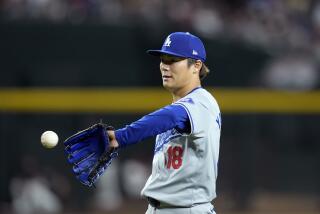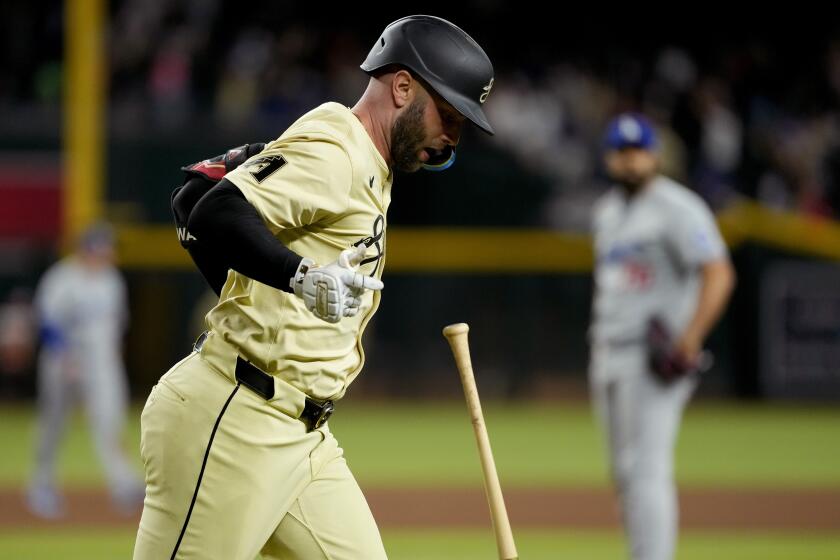They’ve Rebuilt the Farm
In the batting cages at Dodgertown, wrapped in catcher’s gear, staring through horizontal bars, pelted by hard and undeveloped sliders, Russell Martin still knew.
He had left third base at the passing suggestion of it, not because he didn’t like it there, where the air isn’t clogged with quite so much dust or mayhem.
They told him a big league journey of a thousand contusions began with a single squat. He believed them.
Martin could not have known it, but he was becoming a symbol of a new Dodgers organization, rebuilt from the bottom up. He did not mark the beginning of it, or the best of it, or even the last of it. He was just a good kid, adequately skilled, with a malleable psyche and a rigid spirit.
He held that new mitt as steady as he could while a Dominican right-hander named Jose Diaz, big enough that everyone called him Jumbo, became his first battery mate.
In the weeks that followed, Martin graduated to intrasquad games on the back fields, where coaches such as Jon Debus, Travis Barbary and Dann Bilardello observed from a screen set up a few feet off his heels. When his half-innings were through, he sat beside them, and they asked him about pitch selections, talked him through in-game quandaries, then patted his shoulder and sent him out again.
It was the fall of 2002. Martin, raised in Canada, had been drafted that June from Chipola Junior College in Marianna, Fla. He’d gone in the 17th round, following better-known prospects James Loney, Greg Miller and Jonathan Broxton, among others. But it didn’t matter to him.
“Every year I played, I was trying to make the big leagues right now,” he said. “It never felt far away.”
From the toehold of those afternoon games, half an inning catching, half an inning listening, an organization pushing from behind, it was 3 1/2 years.
“I saw him have some tough nights,” said Terry Collins, then the Dodgers’ minor league field coordinator. “He went to the backstop a lot of times. A lot of times. But he stuck with it.”
Dan Evans, the general manager hired during the 2001 season, had arrived at Dodger Stadium to find a flawed, pricey major league roster, with $210 million in guaranteed salaries spread through future seasons, and a farm system ranked 28th out of 30 teams by Baseball America.
By the 2002 draft, Evans had hired Kim Ng as assistant general manager, Bill Bavasi as farm director, Logan White as amateur scouting director and Collins, who in three years would replace Bavasi. Evans eventually would be replaced too, first by Paul DePodesta, then by Ned Colletti, as owner Frank McCourt adjusted and readjusted his baseball vision.
Bavasi resigned to become general manager of the Seattle Mariners, where he hired Evans as a consultant and scout. Roy Smith was hired from the Pittsburgh Pirates to serve as director of scouting and player development, wedding those two departments, and less than a year later DePodesta, who hired him, was fired. Dozens of scouts and other baseball minds -- John Boles and Joey Amalfitano included -- washed in and out of the organization, stability gone the way of the Garvey-Lopes-Russell-Cey infield.
And, yet, through three regimes, through some marginal successes and many more malfunctions at the big league level, the farm system has become, at the very least and by recent appearances, reliable.
White has run five drafts. From those, and the handful of players left from Evans’ predecessor, Kevin Malone, along with trades and international signings, the Dodgers’ farm system, by Baseball America’s estimation, has rated second for three years running.
“That happened,” Evans said recently, “because a lot of good people were on the same page.”
On June 10 against the Colorado Rockies, Matt Kemp started in left field, Joel Guzman at third base, Martin at catcher, Willy Aybar at second base. Five days later, Chad Billingsley made his big league debut, a game in which Broxton was the winning pitcher and Andre Ethier, acquired by Colletti in a trade with the Oakland Athletics, started in left field.
“We just had a good combination of kids coming through the draft, and through international, that are beginning to surface,” said Jeff Schugel, a former Dodgers director of international scouting who is now a major league scout with the Angels.
It began, according to those who were there, after the 2001 season. The Dodgers had won 86 games for a second consecutive season and finished third in the NL West. Chan Ho Park, then 28, had won 15 games and thrown 234 innings. He also was a free agent, represented by Scott Boras.
Although he’d pinned his organizational objectives to pitching and defense, Evans chose to let Park leave. With the compensatory draft pick received from the Texas Rangers in exchange for signing Park, the Dodgers took Miller, a left-handed pitcher from Esperanza High.
The plan was this: Avoid the high-end free agents when possible, because of their cost not just in big-league payroll, but in compensatory draft picks. When the Dodgers courted Vladimir Guerrero after the 2003 season, for instance, he had not been offered arbitration by the Montreal Expos, and therefore was not subject to those compensation rules.
And this: Just pick the best player. Although the draft swung toward college players, and still leans toward them, the Dodgers have fairly consistently selected high school players. Of their current top 10 prospects, five (Billingsley, Broxton, Scott Elbert, Blake DeWitt, Kemp) were drafted out of high school, two (Andy LaRoche, Martin) out of junior college and three (Guzman, Tony Abreu, Chin-Lung Hu) were foreign-born, undrafted free agents. In the 2006 draft, the Dodgers, in the seventh spot, took the first prep player -- left-hander Clayton Kershaw, from Dallas.
Through his research, White came to believe the “Moneyball” system had devalued the high school player, leaving better prep players available later in the draft. Because the Dodgers generally picked middle to late in the first round, he said, “For a good college guy to get to us at 24 or so, somebody’s going to have to make a mistake.”
White also found that although exceptional high school players -- those who become everyday major leaguers and All-Stars -- generally take longer to reach the major leagues than college players, the difference was less than he thought: half a year to a year.
He asked his area scouts to be especially aware of a player’s competitive makeup, then trusted the scouts’ judgments. In the 2003 draft, the Dodgers believed Kemp, who split his time between baseball and basketball at Midwest City High in Oklahoma, probably could be had in the 12th round or later, but selected him in the sixth.
“Logan loved the kid,” Evans said, “and he relied on the area scout.”
Another, LaRoche, was widely assumed to be headed to Rice after the 2003 season. The Dodgers took him in the 39th round and persuaded him to sign with a $1-million bonus.
White’s first draft, in 2002, was rated by Baseball America as the fourth-best in the game, the 2003 draft best overall and the 2004 draft second-best. In 2005, the Dodgers lost their first-round pick through the signing of Derek Lowe, selected Tennessee right-hander Luke Hochevar in the 40th spot, and did not sign him. Hochevar went first overall to the Kansas City Royals this year.
So, the talent arrived in places such as Vero Beach, Fla.; Santo Domingo, Dominican Republic; Ogden, Utah; and Columbus, Ga. Billingsley and Chuck Tiffany went to Ogden. Martin, Kemp, Guzman and Edwin Jackson went to Vero Beach, and Broxton to Great Falls, Mont.
There, they found Ken Howell. Or Debus, Collins, Dave Wallace, Roger McDowell, Mariano Duncan or Rick Honeycutt.
“They kept feeding me positive things,” said Jason Repko, drafted as a shortstop in 1999 and converted to the outfield after three minor league seasons.
Honeycutt and other pitching coaches handed their prospects the baseball and had them learn to throw a fastball, for command and velocity. They routinely forbade minor league pitchers from throwing breaking balls, sometimes for starts at a time. Collins and hitting instructors handed their prospects a bat and had them learn the strike zone, then to hit a fastball.
“Kenny Howell is basically my mentor,” Billingsley said. “He taught me so much about everything. About being a professional, and the mental part of pitching, and he moved up the ladder with me. We understood each other.”
Bavasi, then the farm director, believed in pushing the Dodgers’ prospects through the organization, challenging them to catch up to the next level. Billingsley, for example, skipped low Class A and, at 19, was promoted from rookie ball to high Class A. Martin, a catcher for only two years when he left Vero Beach, and Kemp weren’t allowed to become comfortable in the low minors before pressing toward the big leagues.
“I really believe in challenging players,” Collins said. “I’m all for minor league success. I also believe in producing a winning player, a player who has won in the minor leagues. But first the player has to get better. If that comes at the cost of winning, then so be it.”
Once, it was an organization that produced rookies of the year annually. Then it didn’t.
More than a decade later, the Dodgers have again scouted, drafted and developed well enough to bring health to the organization.
“It has nothing to do with one person,” Collins said. “It starts with Logan and his guys finding the players, then allowing us to do what we think needs to be done to make the players better.”
*
Begin text of infobox
Blue-chip talent
The Dodgers are battling for the National League West in part because of the production of several first- and second-year players.
*--* BATTER G AB R H 2B 3B HR RBI BB K SB CS AVG. Andre Ethier 49 131 19 42 7 1 4 20 10 28 1 3 321 Jason Repko 25 69 13 21 4 1 3 12 8 14 8 1 304 Matt Kemp 26 88 20 26 5 0 7 18 8 30 4 0 295 Russell Martin 45 160 23 47 8 2 4 33 17 22 3 1 294 Willy Aybar 35 106 14 29 9 0 3 20 12 15 1 0 274 James Loney 14 40 4 9 1 1 0 3 3 2 0 0 225 Joel Guzman 8 19 2 4 0 0 0 3 3 2 0 0 211
*--*
*--* PITCHER G GS W L SV IP H R ER HR BB K ERA Jonathan Broxton 27 0 1 0 0 31.1 25 11 10 5 13 40 2.87 Chad Billingsley 3 3 0 1 0 16.0 18 10 10 1 13 6 5.63
*--*
*
Source: sports.yahoo.com
More to Read
Are you a true-blue fan?
Get our Dodgers Dugout newsletter for insights, news and much more.
You may occasionally receive promotional content from the Los Angeles Times.





